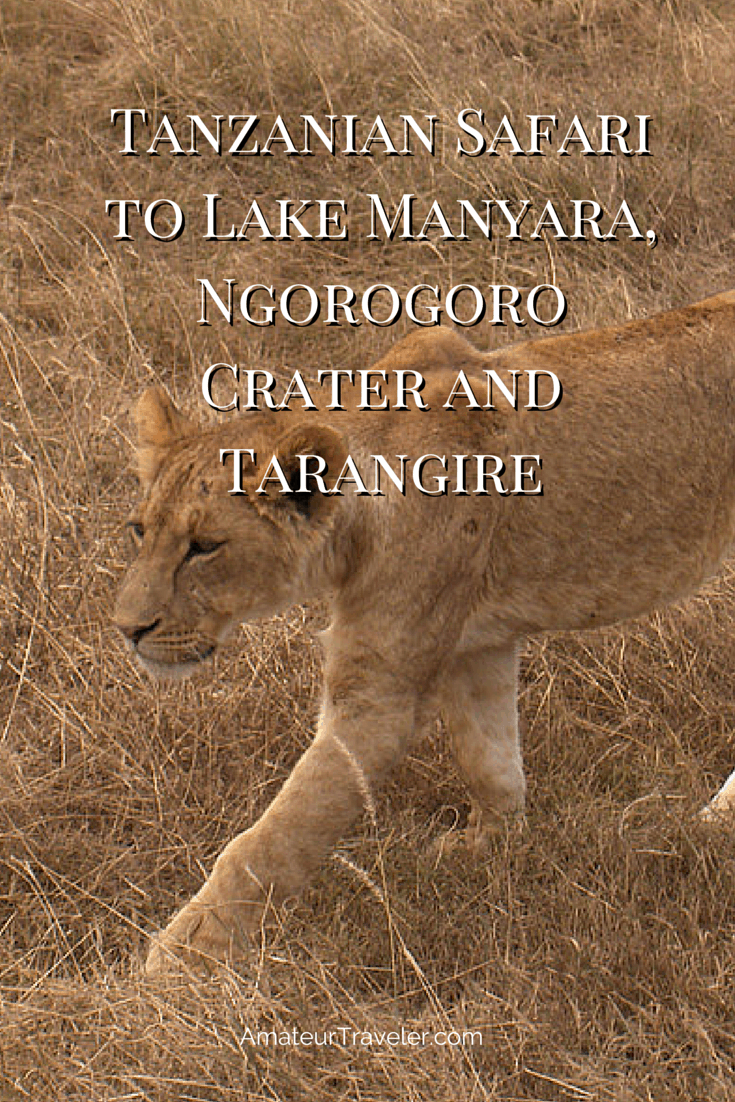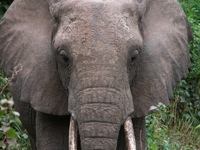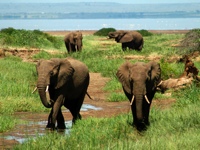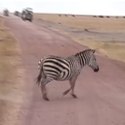Tanzania – Best Safari Destinations (Lake Manyara, Ngorongoro Crater and Tarangire)
categories: africa travel
I am sure you think you know what the roar of a lion sounds like. Whether you grew up watching Animal Planet or Wild Kingdom we have all heard the sound. But when the lion is less than 4 feet away there is a deep-seated visceral reaction to that sound like some ancestral voice reminding you “hey buddy, you weren’t always at the top of the food chain”.
Encounters like mine with the lion above are common at three very popular game parks in Northern Tanzania. All three are a quick drive from the gateway city of Arusha.
Lake Manyara
The first of the three parks is Lake Mayara. Mayara is a Maasai word for the thorny Acacia tree common in this part of Africa. The elephants and other animals at Lake Manyara are only passing through. Like the rest of the parks, this one has no fences and no borders that the elephants would respect. They come and go from further South in Tanzania to further North in Kenya.
The park is visited in a vehicle like a RangeRover with a large hole in the top where around 5 tourists poke their heads out to try and capture the spectacle. A zoom lens is a must and a monopod is recommended. There is no room in the vehicle for a tripod. You won’t get quite close enough to reach out and touch an elephant but you will be able to capture their image like this craggy mud-caked face of a bull elephant.
No matter how many times you have seen a giraffe on television, the real thing still seems somewhat improbable if not impossible. These tall “gentle” creatures are a symbol of peace in Tanzania, yet can kick a lion to death if attacked. Lake Mayara hosts the Maasai giraffe. The average male is 17 feet tall. As impossible as it seems they give birth standing up and the drop is what cuts the umbilical cord. A mother giraffe is pregnant for 400-460 days and her baby is 6 feet tall. The baby can walk within hours of birth.
Lake Mayara is also home to troupes of baboons. As much as I enjoyed the park I can’t say it seemed vastly different from visiting a wild animal park in the United States.
Ngorongoro Crater
Ngorongoro is where my brain finally came to understand that I was really in Africa. The circular shape of the crater reminded the native Maasai of a cow’s bell and the name comes from the sound a bell makes. Here instead of seeing a few animals as you descend from the rim you see herds of zebras and wildebeests that seem to go on to the horizon.
The Maasai are allowed to herd their animals down to the crater but no one is allow to visit after nightfall. The rules of the road are somewhat different in the crater where the wildebeests have the right of way.
We saw warthogs, Thompson’s gazelles, hyenas, flocks of flamingos, and pools of hippos. As we were watching one cheetah mother walk through the grass it scared up a rabbit, which it quickly chased down for dinner. They take this circle of life thing very serious in Ngorongoro. It was one more reminder that this is not a zoo. These are wild animals.
- Get an eSim to be able to use your smartphone abroad.
- Book Your Accommodation HERE
- Search for Great Tours HERE
- Get a Car Rental
- Buy Travel Insurance
- Get a universal plug adapter

We saw the endangered “white” rhino in the distance. There are no more than a dozen rhinos in the park. The people in our party, as well as the nearby vehicles, seemed subdued by the knowledge that we might be viewing an animal that may soon disappear in the wild.
Throughout the crater, we bounced along on the dirt roads. The braver or more foolhardy road standing up as we tried to spot the more elusive wildlife. Slowly we turned the color of the dusty roads except for beaming white smiles.
It was not until after lunch that we finally saw the lions. The picture above is not a lion that was hit by a car but a sleepy lion that decided to take a nap wrapped around the tire of one unfortunate Range Rover. The occupants were trapped until the lion decided to wake. Unfortunately, a male lion sleeps 20 hours a day and the Range Rover was still parked there the last I saw.
Tarangire
Our final stop is Tarangire. Frankly, after Ngorongoro, Tarangire was a bit anti-climactic. We saw more elephants, more giraffes, and more zebras, but Tarangire does not offer as many vast landscapes as Ngorongoro.
Tarangire also is the home to lions, monkeys, ostriches, and leopards. A leopard would be the only one of the so-called “big 5” that we did not see. The big 5 are leopards, lions, elephants, rhinos, and Cape buffalo and were considered the most dangerous of the African animals to hunt on foot. For those of us hunting with a lens instead of a rifle, the leopard is the most elusive of this group as it is a nocturnal and solitary hunter. We did spot where a leopard had stored its kill up in the branches of a tree.
The best feature of this park is that, unlike Ngorongoro, you can eat (or sleep) at the lodge in the park. Get a seat on the veranda where you can watch the elephants migrating. Get a cold Tusker beer and a great tasting hamburger and tell yourself. “I’m top of the food chain now”.
Conclusion
A wildlife safari in Africa is a once in a lifetime experience. Getting to Africa is expensive and time-consuming for those of us in the Northern hemisphere, but the experience is amazing. No zoo experience will ever compare. If you are a photographer or just someone who loves wildlife, add Northern Tanzania to your bucket list.
Logistics
The easiest way to visit all three parks is to arrange a tour with a local guide. I used JMTours out of Arusha that booked a 2 and a half-day outing including 2 nights in a safari lodge for a reasonable price.

+Chris Christensen | @chris2x | facebook












 Travel to Tanzania – Lake Manyara National Park – Video Episode 7
Travel to Tanzania – Lake Manyara National Park – Video Episode 7 Tanzania, Africa as a Tourist – Episode 51
Tanzania, Africa as a Tourist – Episode 51 Travel to Tanzania for a Safari – Episode 27
Travel to Tanzania for a Safari – Episode 27 Travel to Tanzania, Ngorogoro Crater part 1 – Video Episode 11
Travel to Tanzania, Ngorogoro Crater part 1 – Video Episode 11

Vicky
Says:March 19th, 2012 at 10:12 am
The Ngorogoro Crater sounds amazing! And lucky me, I’m going in three months! I can’t wait to see the animals in the wild. Really, really hope I see a giraffe – they’re definitely the coolest!